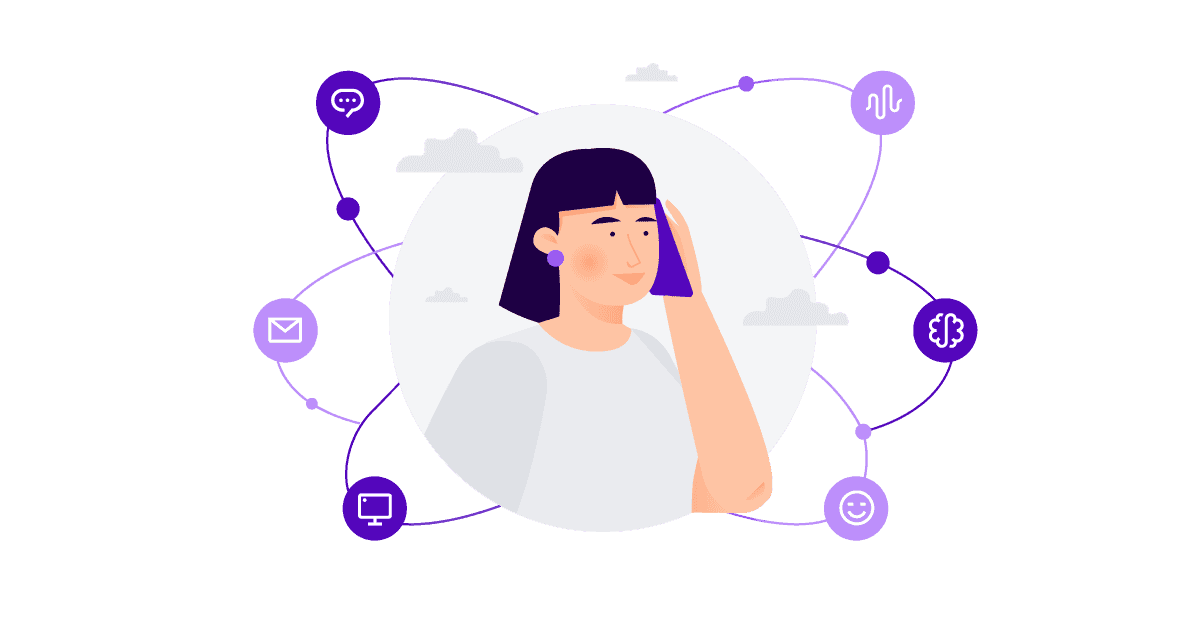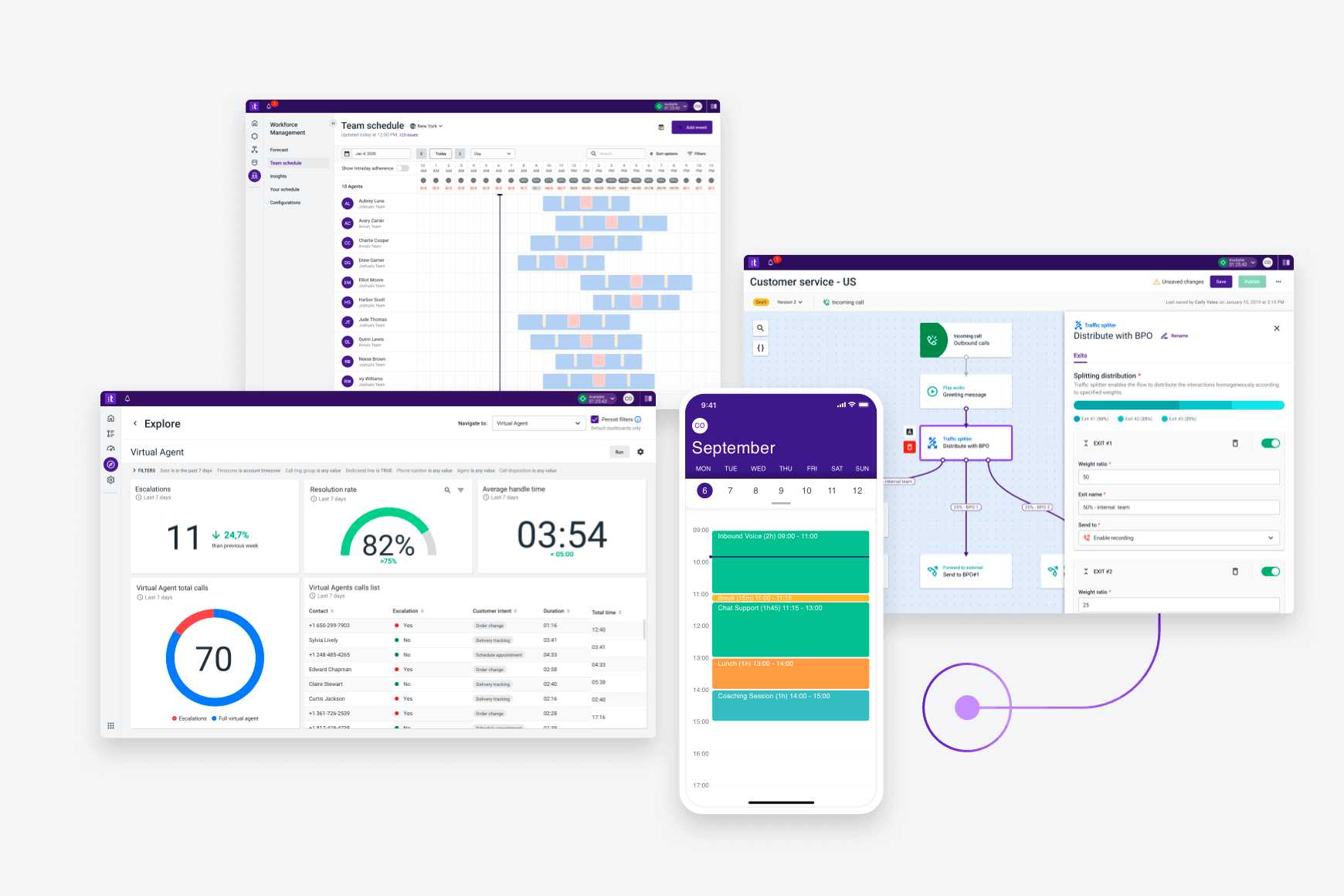Contact Center Trends
The ultimate guide to building an omnichannel customer experience

By Celia Cerdeira
0 min read

Are you struggling to provide a seamless and personalized customer experience across multiple channels? Is your contact center facing challenges in integrating customer data from different platforms? If so, you’re not alone. Many contact centers grapple with the complexities of implementing an effective omnichannel customer experience strategy.
Customers today expect convenience, consistency, and personalization at every touchpoint—especially when multiple channels are involved. But fragmented digital and offline channels, disjointed systems, and disconnected data often make it harder for contact centers to meet these expectations. When customers have to repeat information, encounter inconsistent messaging, or run into barriers when switching between digital channels and over-the-phone touchpoints, they get frustrated. And frustrated customers may take their business to a different contact center.
Fortunately, it’s very possible to build an omnichannel customer experience that not only keeps your customers satisfied but also makes your contact center the obvious solution to all of their problems.
In this guide, we’ll show you:
- What an omnichannel customer experience is, and why it matters for your contact center.
- How omnichannel customer service works—and what makes it work well.
- The four key elements that spell the difference between a successful omnichannel experience and a failed one.
- Why contact centers need omnichannel customer service now more than ever.
What is an omnichannel customer experience?
An omnichannel customer experience refers to a seamless and integrated approach to customer interactions across multiple channels and touchpoints. It aims to provide a consistent and cohesive experience for customers, regardless of the channel or device they use to engage with your business.
Brands typically operate across multiple channels such as a brick-and-mortar store, websites, mobile apps, contact centers, social media platforms, and more. However, these channels often operate in silos, with limited communication or synchronization between them. This fragmented approach often leads to inconsistent information, disjointed experiences, and frustrated customers.
For example, a customer might call your contact center to ask a question about a bill. After a conversation with one of your agents, they might be asked to provide additional information online or via a mobile app. After submitting the paperwork, they follow up through live chat to find out if their information has been received.
The problem is, these different channels don’t always talk to each other. So the information the customer shared on the phone, which the service rep wrote down for their own future reference, may not make it onto the mobile app’s records of that same customer. The customer is faced with a frustrating lack of communication, ends up repeating their information multiple times to multiple people on multiple platforms, and often spends way more time than necessary getting their issue resolved.
In contrast, an omnichannel customer experience seeks to break down these silos and create a unified and synchronized experience across all channels. With an omnichannel approach, the customer’s information would be synchronized across all of your contact center’s channels. That way, the live chat representative, the phone representative, and the social media representative would all have access to the customer’s full online messaging and phone call history. Any one of your representatives at any time could complete the inquiry seamlessly, regardless of the channel your customer makes contact through.
What makes a good omnichannel customer experience?
The key components of a good omnichannel customer experience include:
- Channel Integration: All channels, including digital channels, are connected and can share customer data, purchase history, and preferences.
- Consistency: Customers receive consistent information, branding, pricing, and promotions across all channels.
- Seamless Experience: Customers can start, pause, or complete a transaction or inquiry across channels without any disruptions.
- Personalization: Your contact center tailors the experience based on customer data and preferences to provide relevant recommendations and offers.
- Customer Data Integration: Customer data is centralized across different channels to create a single customer view, enabling better insights and more personalized interactions between your customer representatives and customers.
Why is omnichannel important for customer experience?
Increased customer satisfaction and loyalty.
Omnichannel customer experience plays a crucial role in enhancing customer satisfaction and fostering loyalty. By providing a seamless and consistent experience across multiple channels, your agents can give customers the convenience of starting an interaction on one channel and seamlessly continuing it on another without having to repeat information. This convenience helps your customers feel valued and supported through their interactions.
Satisfied customers are more likely to become loyal advocates, recommend your brand to others, and provide positive reviews. They’re also more inclined to make repeat purchases and engage in long-term relationships with your business.
Higher revenue and sales.
By integrating channels, you can increase customer engagement and make it easier for customers to find, research, and purchase your products or services. This seamless experience enables your customers to move through your sales funnel more smoothly, resulting in higher conversion rates. Additionally, omnichannel personalization allows your representatives and sales teams to offer targeted recommendations, promotions, and upsell/cross-sell opportunities, increasing the average order value.
The ability to track customer journeys across your channels also provides valuable insights into your customers’ behavior, allowing businesses to optimize your marketing efforts, and allocate your resources more effectively.
Competitive advantage.
In a competitive market, businesses that excel in delivering an omnichannel customer experience gain a significant advantage over their rivals. By providing a consistent and convenient experience across multiple touchpoints, you can differentiate your business and create a positive brand image. This competitive advantage translates into customer loyalty and retention, as customers are more likely to choose a brand that consistently meets their needs. Furthermore, with robust omnichannel capabilities, you can attract new customers who are seeking a superior customer experience.

ebook
Making the move to omnichannel
Download our free eBook to learn more about the concept of omnichannel customer service and how to decide which channel is most appropriate for a particular situation.
The four key elements of a successful omnichannel customer experience.
Personalized experience.
An effective omnichannel customer experience strategy tailors interactions and offerings based on customer preferences, behaviors, and demographics. This personalization creates a more engaging and relevant experience for customers, strengthening their connection to your brand and increasing their satisfaction.
Comprehensive customer data management.
Effective omnichannel experiences capture, organize, and integrate customer data from various touchpoints and channels into a unified view. This data can include purchase history, preferences, browsing behavior, and demographic information. By centralizing and analyzing this data, you can gain insights into customer behavior, identify patterns, and segment your customer base for personalized targeting, as well as ensure that all customer experiences are supported by the correct and up-to-date data. Robust data management practices also ensure data accuracy, security, and compliance with privacy regulations, fostering customer trust.
Seamless integration.
Seamless integration is a fundamental element of an omnichannel customer experience. It requires connecting and synchronizing your channels, systems, and processes to provide a cohesive customer journey. This integration allows your customers to switch between channels effortlessly, without losing context or needing to repeat information.
Advanced analytics and insights.
By analyzing customer data across channels, you’ll be able to uncover trends, identify pain points, understand your customer’s preferences, and optimize touchpoints for better customer engagement.
Advanced analytics also help measure the effectiveness of your marketing campaigns, track customer progress through your sales journey, and quantify the impact of your omnichannel experience on your organizational goals.
By focusing on these key elements, you can create a customer-centric omnichannel experience that drives customer satisfaction, strengthens brand loyalty, and generates your business growth.
Challenges in implementing an omnichannel customer experience.
Implementing an omnichannel customer experience presents several challenges. In fact, if you don’t have a plan to overcome these, you may damage your brand reputation rather than improve customer experience. Here are two of the biggest issues you could face when building an omnichannel customer experience:
Channel integration.
Integrating outdated systems or platforms that don’t play well together can cause headaches, often requiring investment in yet more software or in hiring outside help. If your representatives can’t access all channels on the same platform, they can spend additional manual time switching between platforms, leaving room for errors and reducing the volume of inquiries they can resolve in a shift. These kinds of integration issues cause ongoing customer service problems—and as the customer experience worsens, so does your company reputation and brand image.
Organizational silos.
Your business may also be operating in silos, with different teams managing separate channels. Overcoming these silos and fostering collaboration can be challenging, especially if the silos have years or decades of everyday use behind them. This could require you to employ change management consultancy to help your team adapt to new systems, adding additional costs to your digital transformation strategy.
To tackle these challenges and create a frictionless customer experience, you need a purpose-built platform with automation-first solutions. Talkdesk Omnichannel Engagement is an end-to-end solution that allows you to engage with your customers on their channel of choice, while giving your representatives a completely integrated view of all communications, regardless of the channel. This eliminates silos and simplifies data management for your representatives.
To learn how Talkdesk delivers a holistic customer experience that drives your business growth, learn more about our Omnichannel Engagement features for contact centers, or request a demo of Talkdesk today!

Interactive demo
Take a self-guided tour of Talkdesk
See how Talkdesk makes the customer experience the best it can be by trying one of our self-guided demos.






